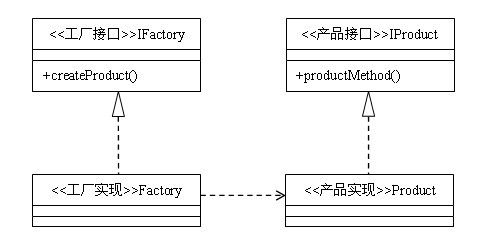今天开始复习设计模式。设计模式相关的资料有很多,概念性的东西就画个图就可以了。把关注点放在例子上,设计模式还是要使用中才有感受。
从Factory Method&Abstract Factory开始。
一、Factory Method
工厂方法模式的用意是定义一个创建产品对象的工厂接口,将实际创建工作推迟到子类中。

我们的例子如下:
我们项目中有一个代码提交记录releasenote,我们需要将这个releasenote分成csv/xls/xml格式分别导出

1 public interface ReleasenoteFactory { 2 3 public Releasenote exportReleasenote(); 4 5 }
1 public interface Releasenote { 2 3 public void exportFile(); 4 5 }
1 public class CSVReleasenoteFactory implements ReleasenoteFactory { 2 3 @Override 4 public Releasenote exportReleasenote() { 5 // TODO Auto-generated method stub 6 return new CSVReleasenote(); 7 } 8 9 }
1 public class CSVReleasenote implements Releasenote { 2 3 @Override 4 public void exportFile() { 5 csvOperation(); 6 } 7 8 public void csvOperation(){ 9 System.out.println("CSV"); 10 } 11 12 }
1 public class XlsReleasenoteFactory implements ReleasenoteFactory { 2 3 @Override 4 public Releasenote exportReleasenote() { 5 // TODO Auto-generated method stub 6 return new XlsReleasenote(); 7 } 8 9 }
1 public class XlsReleasenote implements Releasenote { 2 3 @Override 4 public void exportFile() { 5 xlsOperation(); 6 } 7 8 public void xlsOperation(){ 9 System.out.println("xls"); 10 } 11 }
1 public class XmlReleasenoteFactory implements ReleasenoteFactory { 2 3 @Override 4 public Releasenote exportReleasenote() { 5 // TODO Auto-generated method stub 6 return new XmlReleasenote(); 7 } 8 9 }
1 public class XmlReleasenote implements Releasenote { 2 3 @Override 4 public void exportFile() { 5 xmlOperation(); 6 } 7 8 public void xmlOperation(){ 9 System.out.println("xml"); 10 } 11 }
客户端的调用如下:
1 ReleasenoteFactory F1 = new CSVReleasenoteFactory(); 2 ReleasenoteFactory F2 = new XlsReleasenoteFactory(); 3 ReleasenoteFactory F3 = new XmlReleasenoteFactory(); 4 5 F1.exportReleasenote().exportFile(); 6 F2.exportReleasenote().exportFile(); 7 F3.exportReleasenote().exportFile();
二、Abstract Factory
抽象工厂模式是工厂方法模式的升级版本,他用来创建一组相关或者相互依赖的对象。他与工厂方法模式的区别就在于,工厂方法模式针对的是一个产品等级结构;而抽象工厂模式则是针对的多个产品等级结构。在编程中,通常一个产品结构,表现为一个接口或者抽象类,也就是说,工厂方法模式提供的所有产品都是衍生自同一个接口或抽象类,而抽象工厂模式所提供的产品则是衍生自不同的接口或抽象类。
在抽象工厂模式中,有一个产品族的概念:所谓的产品族,是指位于不同产品等级结构中功能相关联的产品组成的家族。抽象工厂模式所提供的一系列产品就组成一个产品族;而工厂方法提供的一系列产品称为一个等级结构。我们依然拿生产汽车的例子来说明他们之间的区别。

抽象工厂模式,就以《java与模式》中的电脑的例子来学习:
我们知道计算机配件的生产是要配套进行的,PC和MAC是完全不同的两条生产过程,CPU RAM也是完全不同
这个例子中产品族有两个,一个是PC,一个是MAC。产品等级结构有两个,一个是RAM,一个是CPU

1 public interface ComputerProducer { 2 3 Cpu createCpu(); 4 Ram createRam(); 5 6 }
1 public class MacProducer implements ComputerProducer { 2 3 @Override 4 public Cpu createCpu() { 5 // TODO Auto-generated method stub 6 return new MacCpu(); 7 } 8 9 @Override 10 public Ram createRam() { 11 // TODO Auto-generated method stub 12 return new MacRam(); 13 } 14 15 }
1 public class PcProducer implements ComputerProducer { 2 3 @Override 4 public Cpu createCpu() { 5 // TODO Auto-generated method stub 6 return new PcCpu(); 7 } 8 9 @Override 10 public Ram createRam() { 11 // TODO Auto-generated method stub 12 return new PcRam(); 13 } 14 15 }
1 public interface Cpu { 2 3 public void cpuOperation(); 4 5 }
1 public class PcCpu implements Cpu { 2 3 @Override 4 public void cpuOperation() { 5 System.out.println("Pc Cpu processing!"); 6 7 } 8 9 }
1 public class MacCpu implements Cpu { 2 3 @Override 4 public void cpuOperation() { 5 System.out.println("Mac cpu processing!"); 6 } 7 8 9 }
1 public interface Ram { 2 3 public void ramOperation(); 4 5 }
1 public class PcRam implements Ram { 2 3 @Override 4 public void ramOperation() { 5 System.out.println("Pc Ram processing!"); 6 7 } 8 9 }
1 public class MacRam implements Ram { 2 3 @Override 4 public void ramOperation() { 5 System.out.println("Mac Ram processing!"); 6 7 } 8 9 }
最后在客户端调用
1 public class Client { 2 3 public static void main(String[] args){ 4 ComputerProducer pcFactory = new PcProducer(); 5 ComputerProducer macFactory = new MacProducer(); 6 Cpu pcCpu = pcFactory.createCpu(); 7 Ram pcRam = pcFactory.createRam(); 8 Cpu macCpu = macFactory.createCpu(); 9 Ram macRam = macFactory.createRam(); 10 pcCpu.cpuOperation(); 11 pcRam.ramOperation(); 12 macCpu.cpuOperation(); 13 macRam.ramOperation(); 14 } 15 16 }
参考资料:
《Java与模式》